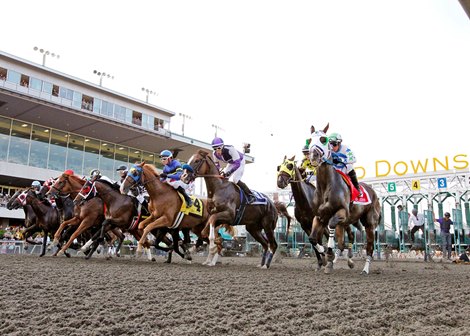Using purse levels to determine the assessment fees that support the Horseracing Integrity and Safety Authority makes sense as a way to help ease the expenses for successful smaller tracks. This current standard, however, will end Jan. 1, 2026, when HISA starts assessing fees based solely on starts.
Oddly, what is driving HISA to make this change is litigation from both expected sources—owners and operators of tracks with big purses—as well as unexpected sources—outlets that would seemingly be opposed to this change but are looking to win a larger legal battle regarding HISA's constitutionality.
For tracks adversely affected by the change to fees based on starts, the impact could be severe. In a March 25 Seattle Times story, executives at Emerald Downs and officials from the Washington Horse Racing Commission said the change in how HISA assesses fees will lead to an 89% increase in the track's HISA expenses come Jan. 1. Those added expenses could result in the track ending racing, as it could become cost prohibitive.
A lawsuit brought by track owners that pay some of the highest purses in the United States, Churchill Downs Inc. and the New York Racing Association, helped push HISA away from including purses in determining its assessments. But then litigation challenging the constitutionality of HISA brought by many horsemen's groups that compete at those smaller-purse tracks—as well as many states where those tracks are located—also took the position that purses should not be considered in these assessments.
HISA adjusted the rule. As the overall costs for HISA will largely not change, this modification to assessments will see some financial burden shift to tracks with lower purses.
While I could argue for either approach, the shame is that racing rarely sits down and works for the best outcome of the sport overall. There's not really a set-up to even facilitate such an approach.
If I were to offer one idea on this issue: It seems like it would make sense for tracks that receive money from added gaming to find a way to help out tracks that do not have access to this resource. Granted, that approach probably wouldn't hold up in court, but if racing somehow agreed to such an approach, it could help out some important tracks that are trying to find a path forward. (If you're saying "pipe dream" to yourself right now, I can't blame you.)

HISA has brought uniform standards to racing's safety and integrity, a pair of issues that enough of racing's major players agreed needed a change that this approach has become a reality. While HISA has brought that uniform oversight in those critical areas, racing's business model rarely considers the overall well-being of the sport in its decisions.
In the case of the assessment fees, HISA largely saw its hand forced by litigation as CDI and NYRA filed lawsuits pursuing what any entity would desire: lower expenses. The strange thing is that while it's in the interests of CDI and NYRA to take such a position to benefit their tracks, HISA says a decision in the litigation involving its constitutionality also fostered the rule change.
On the Federal Trade Commission site, HISA outlined that odd situation as many of the horsemen's groups and states contesting the constitutionality of HISA are tied to smaller-purse tracks that benefit from the current assessment approach.
"Numerous stakeholders have initiated litigation against the Authority over the use of paid purses in the cost methodology rule. In fact, many of these entities benefit from the use of purses in the assessment formula, but nevertheless believe that actual starts should be the sole basis for calculating the assessments.
"For example, in a federal action filed by various West Virginia and Louisiana governmental and horse racing entities, including the Louisiana and West Virginia racing commissions, the court ruled that because the FTC acknowledged that HISA's methodology includes "a metric that is not part of the act's basis of calculation of fees—purses. This Court finds that plaintiffs have shown a likelihood that the assessment methodology rules are unlawful."
The court decision goes on to say, "While there is limited discretion given to HISA for determining funding, it cannot go outside the authority given to it in (the act that created HISA). By adding this additional metric, HISA went outside the bounds of the act and its authority for calculations. Plaintiffs are likely to succeed on the merits on their claim that the assessment methodology rules exceed HISA's statutory authority."
According to the FTC, after remand from the United States Court of Appeals for the Fifth Circuit, a long list of litigants, including the Washington HBPA that races at Emerald Downs, then filed an amended complaint seeking to have the cost methodology rule vacated and enjoined because it includes purses in the assessment formula. The amended complaint states that purses cannot be used in the assessment formula and that the formula should be based on starts.
This approach appears to be a case of litigants hoping to find any toehold in their efforts to find HISA unconstitutional. But it also finds them latching onto a position—basing assessment fees on starts instead of starts and purses—that those tied to small-purse tracks otherwise would oppose.
HISA said that while it believes its current assessment formula that includes purses as a factor is in accordance with the act, the 2026 modification will remove this issue from the constitutional litigation. In other words, taking this path is easier for HISA than keeping purses as part of the assessment process and less costly than defending the position against further litigation.
HISA did go on to note that in landing on the current assessment approach, it initially anticipated stakes races and graded stakes races having higher testing costs. Upon review, it has found its most expensive cases—typically seen in costly litigation—are tied to the level of violation the covered person is accused. For instance, HISA has found that banned substance cases—and the more severe sanctions they carry—are more likely to be litigated than medication violations that carry lesser sanctions.
HISA accepted comments on the assessment fee changes when it was being considered and the Washington Horse Racing Commission opposed the change. The WHRC is not named in the constitutional litigation against HISA that has seen some commissions from smaller states actually oppose the approach of factoring in purses in the assessments.
"Changing this methodology as proposed will likely lead to a breaking point for the industry which could cause irreparable harm and possibly lead to the end of horse racing in some states," the WHRC said. "In 2024, Washington had the lowest purse money paid per start of the 19 states assessed a fee by HISA. Washington's 2025 HISA assessment is $712,125. If the assessment had been based solely on starts, as proposed by HISA, the assessment would be over $1.34 million, an increase of over 89%."
That brings us back to Emerald Downs. With its location in the far Northwest of the country, perhaps many reading this column have not been to Emerald Downs, but the track outside Seattle certainly has brought people to the sport. Its facility—similar to many of the fan-friendly minor league baseball parks built in the past 20-30 years—provides an inviting, clean atmosphere for patrons to enjoy racing. And they've responded, as the track averages nearly 3,500 fans per live race day.
Between races, those patrons can take in the spectacular view of Mount Rainier.
While the added HISA fees are prominent in the Seattle Times story, it's also noted that Emerald faces challenges because state funding that has been in place in recent years has not been approved for 2026. The industry should work to rally support for Washington racing, as it has done in Florida.
Perhaps a sport with a smaller footprint makes a certain amount of sense—but can we see that plan? Surely there's a way for racing to cooperate enough to think about its overall good? From where I'm sitting, racing can not be benefiting from the loss of live racing in the Oakland-San Francisco area, Portland, Ore., and Boston in recent years. Losing Emerald Downs and the Seattle area would be another huge loss.










